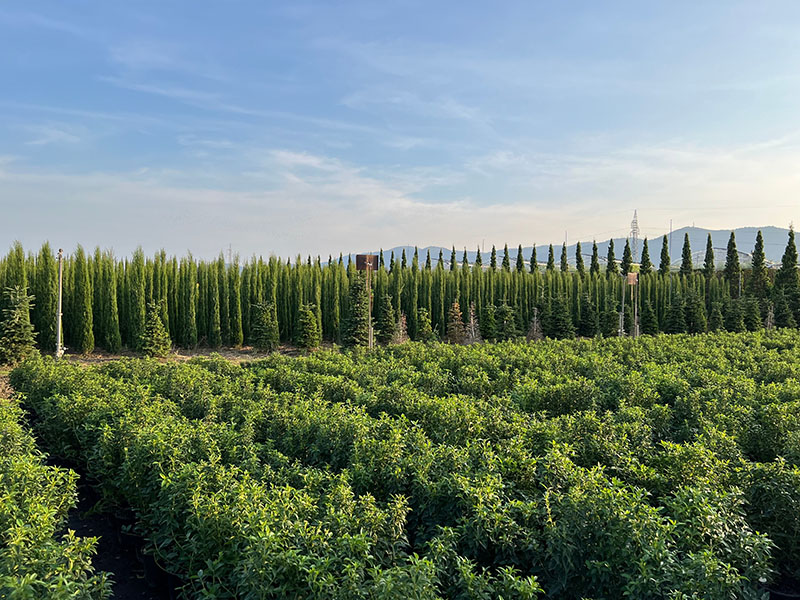by Renato Ferretti
Horticulture in Italy represents 5% of the total value of the agricultural production, and contributes 23% to the European horticultural production. It constitutes a significant, original sector still characterized by a positive economy. In Italy, ornamental horticulture businesses are concentrated in well-defined production areas, each with its particular specialization.
The main flower areas are in Liguria, Tuscany, Campania, Puglia, and Sicily. Meanwhile, those specializing in potted plants, though less concentrated, are mainly found in Piedmont, Lombardy, Veneto, Liguria, Tuscany, and Sicily. In addition to Tuscany, significant outdoor ornamental plant productions are found in Lombardy, Veneto, Marche, Lazio, and Sicily.
Pistoia Ornamental Horticulture District
Ornamental horticulture is the most important activity in Pistoia’s agricultural industry, contributing 25% to the gross product of Tuscany’s agriculture and representing 5% of European horticulture.
It is one of the most important productive districts on the continent. The district is also known for typical productions rooted in the tradition of Tuscan Renaissance farms, such as potted cultivation of citrus and other exotic species, and topiary art for creating variously shaped plants for classic garden decoration.
Ornamental horticulture in Pistoia is concentrated in the Ombrone P.se Valley, covering over 5,200 hectares, with about 1,000 hectares of container cultivation, 1,500 businesses, and over 5,500 direct employees (including 2,500 workers). The turnover is over 300 million Euros, with 160 million Euros exported.
Distribution of Nursery Area in the Province of Pistoia
- Evergreen trees and shrubs: 1,600 hectares
- Conifers: 1,350 hectares
- Deciduous ornamental trees: 1,420 hectares
- Deciduous shrubs: 350 hectares
- Climbers and other shrubs: 280 hectares
- Roses: 200 hectares
Pontine District

The Agro Pontino has become one of the most significant areas for horticulture in the country. Over a hundred companies operate in the province of Latina, providing employment for over 2,000 people and generating a turnover of around 200 billion.
The district is characterized by a focus on Mediterranean plants, and companies often have inter-company organization and relationships to be authoritative public institutions partners.
Canneto sull’Oglio District

The Canneto sull’Oglio district, located in a predominantly flat area on the border of Mantua and Cremona provinces, is recognized as Italy’s leading producer of deciduous trees cultivated in open fields. ù
Covering approximately 3,000 hectares divided among about 200 evenly distributed companies, the nursery activity involves around 1,000 employees.
Canneto is renowned in Europe for its tree production, with structured companies participating in European markets since the 1960s.
Lake Maggiore or Acidophilic District
Lake Maggiore is one of the oldest floriculture areas, specializing in the production of acid-loving plants (azaleas, rhododendrons, and camellias) since the 1970s. About 140 companies operate in the region, covering over 300 hectares, 200 of which are in open fields. The production is mainly for the domestic market, but significant export flows to Central and Northern Europe have developed in recent years.
Sicilian Districts

Floriculture in Sicily originated as a cultural reconversion or productive diversification of agricultural areas previously used for orchards or vegetables.
Notable is the success of the Tyrrhenian side in the province of Messina, where the crisis in the citrus sector led nurseries to shift from citrus reproduction to ornamental citrus. The sector now includes around 300 companies, a thousand employees, and a turnover of around two hundred billion.
The Jonica coastline from Acireale to Calatabiano in the province of Catania is particularly interesting, as ornamental plants gradually replace fruit-bearing lemons and oranges.
Saonara District
The Saonara production district in the province of Padua is one of Italy’s oldest, with over 40% of the approximately 2,000 hectares of nurseries concentrated in the Veneto region’s 1,000 companies.
The productions range from ornamental graden plants to trees for extensive landscaping and forestry.
While oriented towards the local market, companies also operate in foreign markets and Central Europe.
Grottammare District
Another excellent nursery district is in the Grottammare and San Benedetto del Tronto area in the province of Ascoli Piceno, where the cultivation of Mediterranean and subtropical plants like palm trees is widespread.
Around a hundred ornamental horticulture companies operate in this region, and some of Pistoia’s most important companies have production branches here, confirming the district’s characteristics and strong product range integration.













